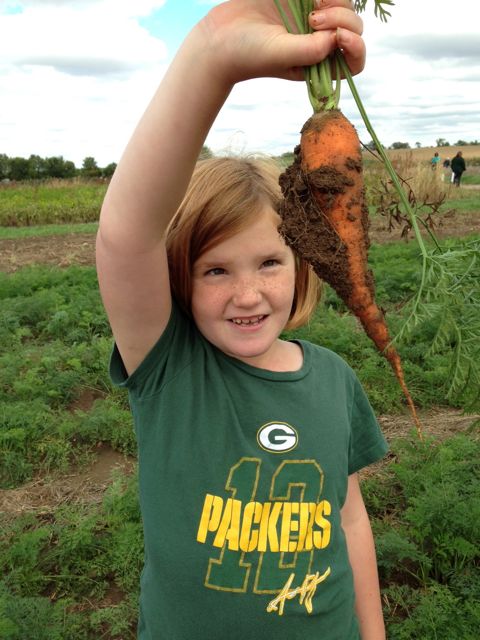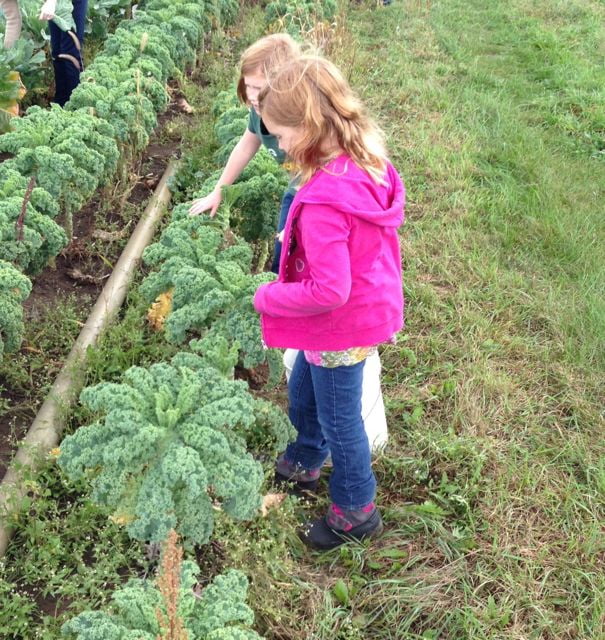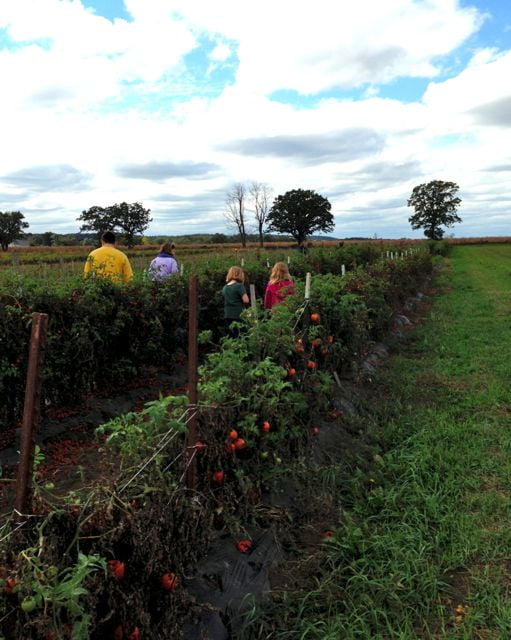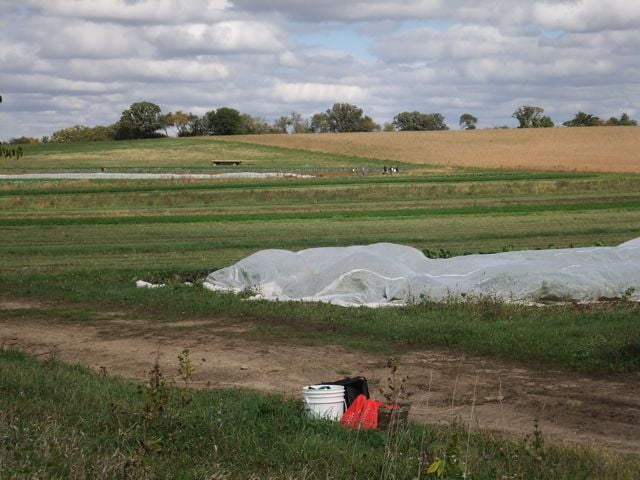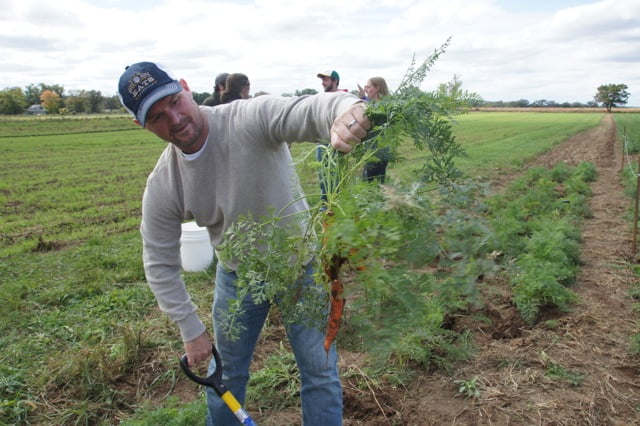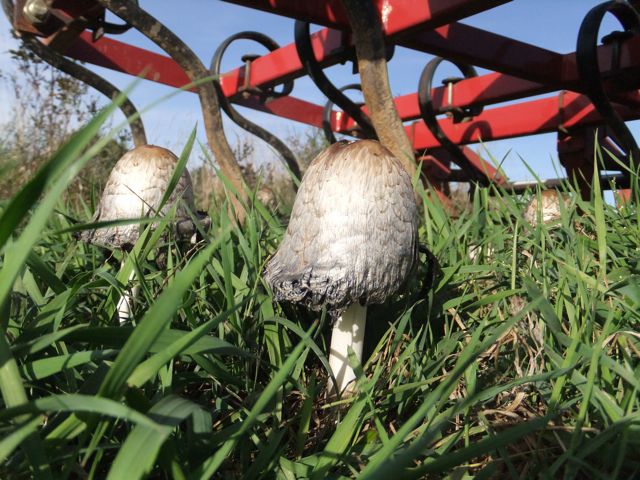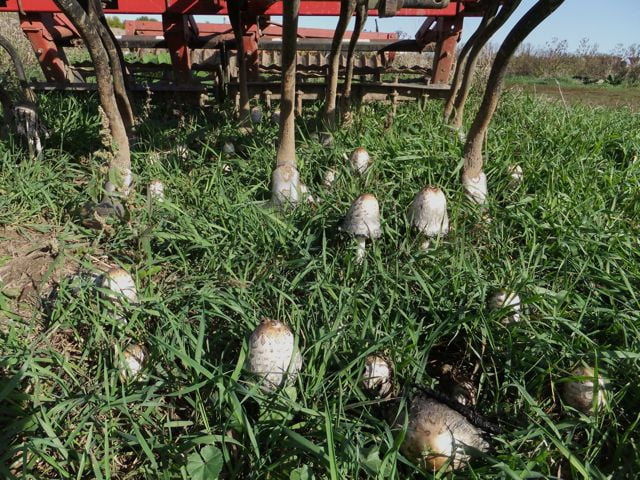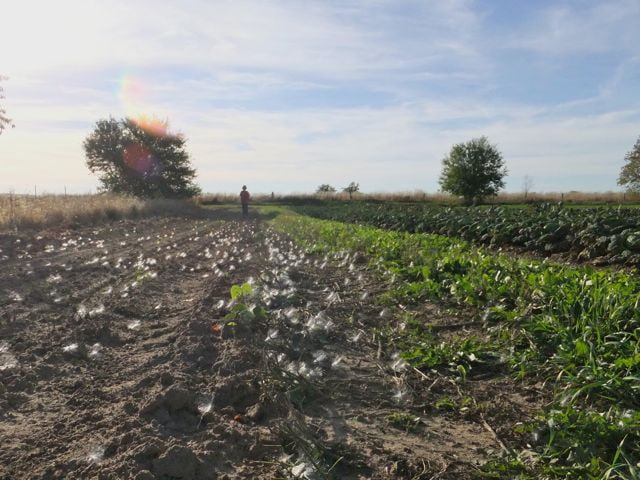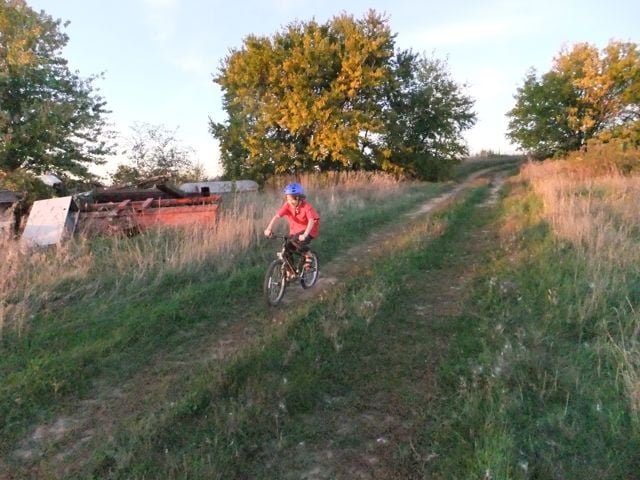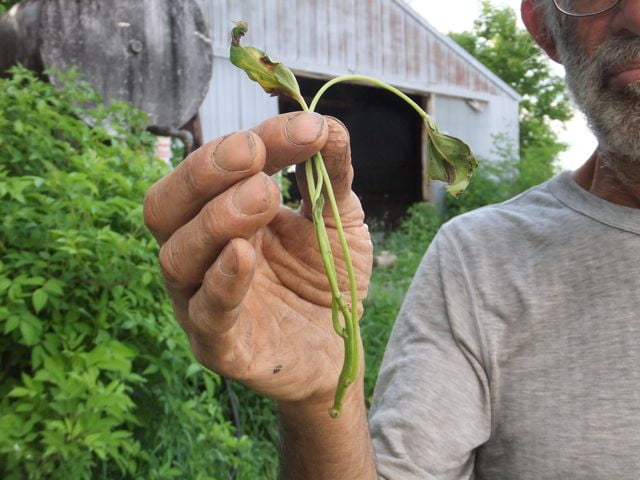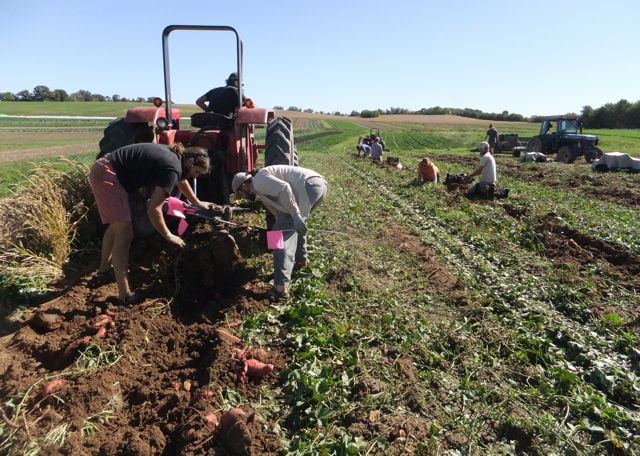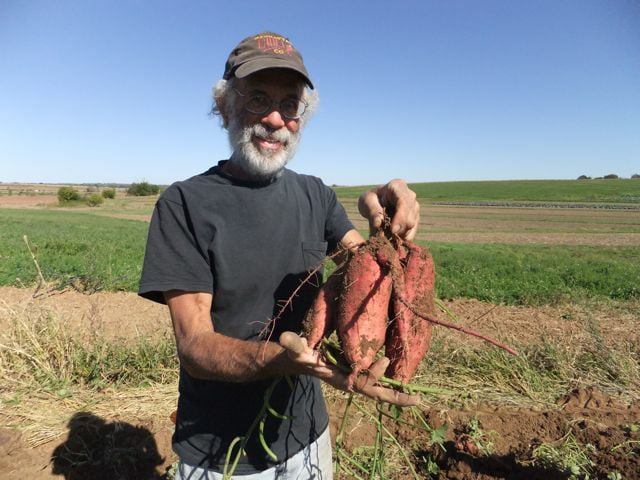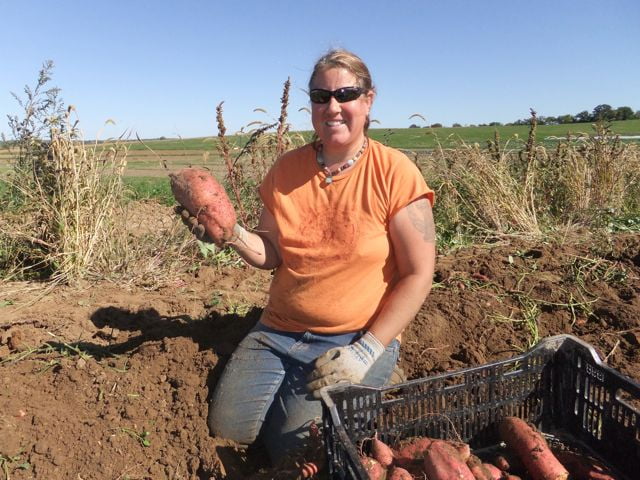Monthly Archives: October 2013
Heads down
- On: October 30, 2013
 0
0
We are pushing hard to gather our storage crops while the weather is still mild. That’s all Steve and I have to report. Beth
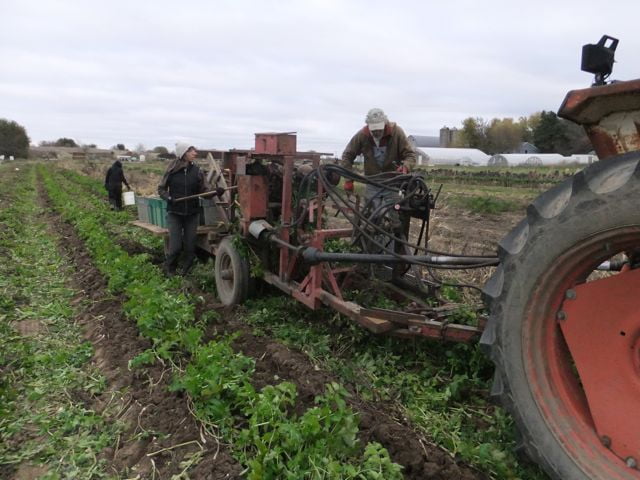
Steve steers our root harvester during parsnip harvest. Kerry keeps the machine clear of leaves.
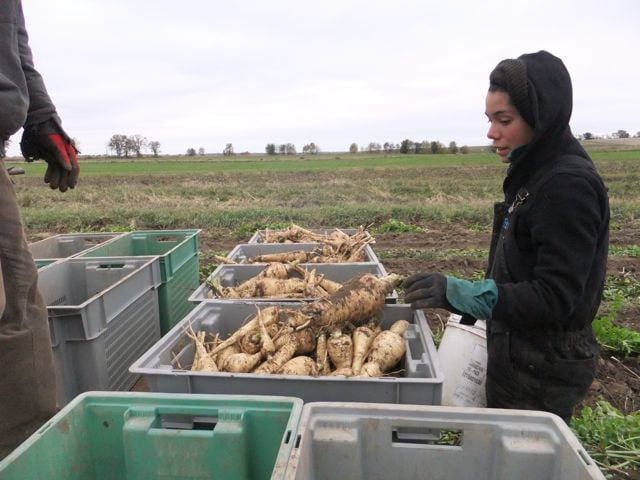
The parsnips are particularly nice this year. Boi helps harvest.
There are two more CSA deliveries after this week.
October 31/Nov. 1 (this week) = green EOW
November 7/8 = Final box for purple EOW members..
November 14/15 = Final box for weekly and green EOW members.
Our winter share deliveries start soon thereafter. I emailed the schedule directly to members registered for those shares. Our winter shares are all sold out.
Veggie List and Veggie Notes (week#24, green EOW)
Pak choy, 1 head
Carrots, 2 lb
Parsnips, about 1.5 lb
Sweet Italian frying peppers, mixed green & red, about 5
Daikon radish, about 1 lb
Yellow onions, 2
Garlic
Parsley, 1 bunch
Winter squash AND/OR Romanesco broccoli
Next week’s box will probably contain russet potatoes, leeks, butternut squash, sweet potatoes, collard greens, carrots, Beauty Heart radish and more.
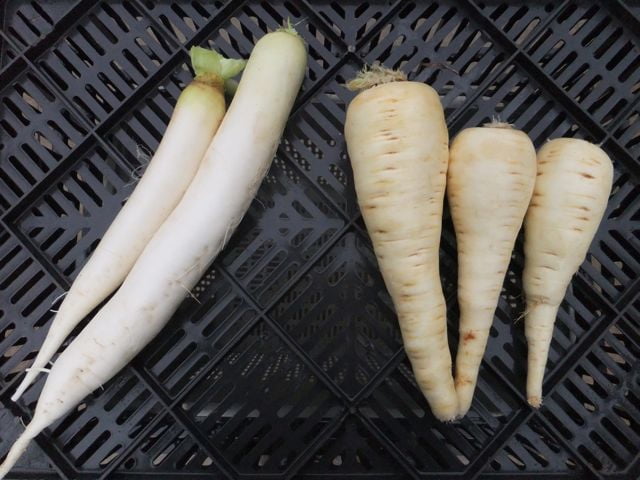
Daikon radish (slender white roots, at left in photo) – These radishes are good cooked or raw. Grated daikon is a nice addition to salads. We often make a salad of grated carrots and radishes, with Asian-style dressing (rice vinegar, mirin, sesame oil, soy sauce, minced garlic).
Parsnips (tapered cream-colored roots, at right in photo) – Those long, white roots are not carrots, they are parsnips. The two vegetables are related. When cooked, parsnips are sweet and starchy. For the best flavor, brown them to caramelize the sugars. Here are a few ideas for parsnip preparation:
– Caramelize the parsnips by roasting them in a vegetable medley.
– Parsnip fries are delicious: cut like French fries, coat very lightly with oil, place on a cookie sheet and roast in a hot oven until brown and cooked through.
– Try substituting grated parsnips in a potato pancake recipe. They brown beautifully and are very tasty.
– Steve loves pan-fried parsnips with onions and garlic.
Pak choy (large head with green stems & leaves) – Looks like bok choy, acts like bok choy.
Italian frying peppers – We’ve held these peppers in storage so please use them quickly. These are sweet peppers, not hot.
Garlic – The heads are quite small. As I explained previously, the garlic crop was terrible across the Midwest. These small heads are our last garlic for the season. Our garlic grower John Hendrickson needs to replant all the remaining large and medium heads for next year’s crop.
Winter squash – Some members will receive winter squash, some will get Romanesco instead. Some will receive colorful Carnival or Celebration squash. See photo below. These are acorn hybrids. The coloring resembles Sweet Dumpling or delicata but the flavor is mild, reflecting their acorn parentage. A few members will receive Sugar Dumpling (not shown in photo; yellow/green striped with smooth shoulder at the stem). These are are smaller and taste like Sweet Dumplings. They resemble the front left squash in the photo.
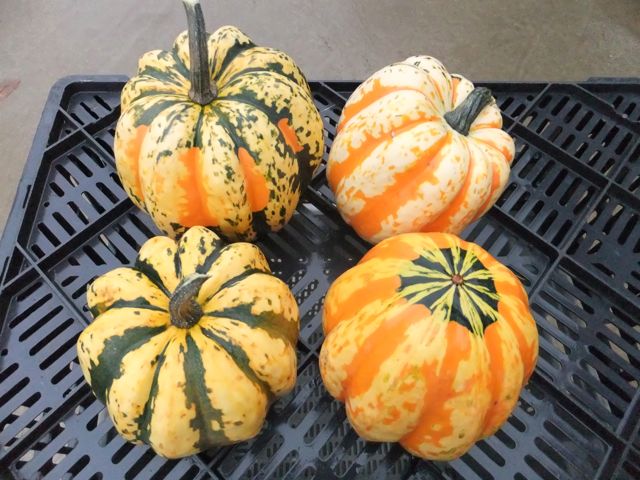
Carnival squash at left, Celebration squash at right.
Is it over yet? No, not yet …
- On: October 22, 2013
 0
0
There are three more deliveries after this week.
October 24/25 (this week) – purple EOW
October 31/Nov. 1 – green EOW
November 7/8 – Purple EOW members get their final box.
November 14/15 – Weekly and green EOW members get their final box.
Farm News: Freeze
It froze hard every night this week, 25 – 26 F. This is not unusual for late October but we were working in shorts just last week. We still have many fall and winter storage crops to harvest. Beets, carrots, leeks, Brussels sprouts, and greens can handle a string of cold nights. Cabbage is more sensitive so we put 40,000 lb into storage this week, enough to last through St. Patrick’s Day in March. Next up on our harvest list: beets, celeriac, and winter radishes. These storage crops are very important to our business. Almost 20% of our yearly sales happen after mid-November, mostly as sales to our store customers.
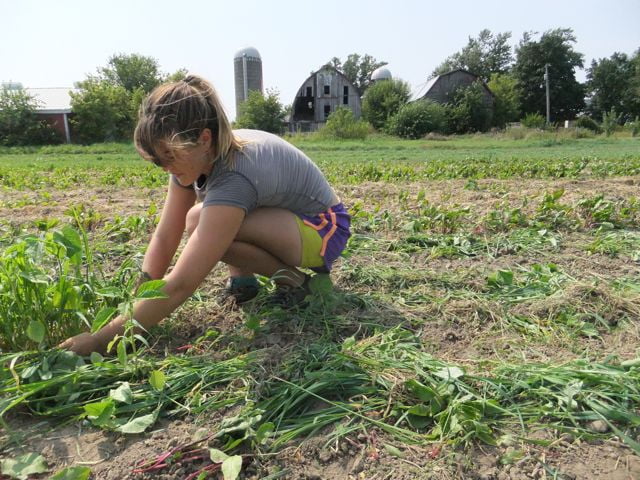
Above, Bri rescues beet seedlings in mid-August. The weeds were enormous. We considered abandoning the planting but did not want to sacrifice the beets.
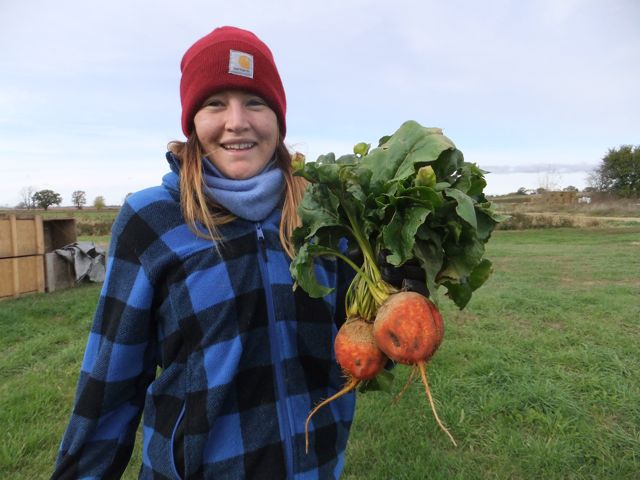
Now two months have passed and we just harvested those beets for your CSA box this week. The extra effort paid off. Above, Bri holds a cluster of golden beets.
One more u-pick photo and comment
Member Robin Schmoldt sent the photo above from our Oct 6 u-pick, and wrote to tell us about her family’s experience that day.
“This year, (our daughter) Emma was ready to go to the farm. She had an absolute blast. For us, it was wonderful to have a chance to start teaching her where good food comes from. For her, it was amazing to see a real farm and not just illustrations in her books. Thank you so, so much for providing this opportunity. Emma’s only two, so she’s still new to this forming-lasting-memories thing, but a week after her visit she would tell everyone she saw about how she “picked broccoli and ‘tee-matos’ and carrots and pumpkins”, so your farm obviously made quite the impression. Thank you again!”
That’s exactly how we hope children will experience our farm events. Sometimes Steve and I get so wrapped up in the planning details (tornado protocol! no dogs!) that we neglect to emphasize the joy of visiting the farm where your food is grown. It can be a great experience at any age. Thank you to all who visited and sent their photos and impressions. We’ve enjoyed your comments so much. Beth
Veggie List and Veggie Notes (week#23, purple EOW)
The broccoli is amazingly productive this year. We planted the usual amount but somehow ended up with much more broccoli than usual.
Red cabbage
Golden OR red beets, 2 lb
Carrots, 2 lb
Leeks, about 1.5 lb
Onion, 1
Broccoli OR Romanesco broccoli, 1 or 2 heads
Bell peppers, 3 or 4
Poblano peppers, 3 or 4
Winter squash, 1 or 2, see note below
Next week’s box will probably contain carrots, parsnips, peppers, garlic and more.
Poblano peppers (triangular, shiny, red or dark green) – These hot peppers have great flavor, especially when roasted.
Bell peppers – We harvested these peppers before the frost. They are mostly red peppers, with a few green, yellow and orange mixed in. We have some Italian frying peppers stashed away for next week’s box. That will be the end of the peppers.
Winter squash – We have many different types of squash to distribute this week. You will receive one or two squash from this list. All types need to be eaten soon. They are all ‘short-season’ types that will not store for long. Store at room temperature with good air circulation, eg on your kitchen counter where you can keep an eye on them.
- delicata (long, slender, striped green and yellow) OR
- Sweet Dumpling (round, striped yellow/green, recessed stem) OR
- Sugar Dumpling (round, striped yellow/green, smooth shoulder at the stem) OR
- acorn squash (round, dark green) OR
- pie pumpkin (looks like a small, solid pumpkin)
Remaining schedule; u-pick photos
- On: October 16, 2013
 0
0
There are four more deliveries after this week.
Here is the schedule for our final deliveries.
October 24/25 – purple EOW
October 31/Nov. 1 – green EOW
November 7/8 – Purple EOW members get their final box.
November 14/15 – Weekly and green EOW members get their final box.
Last chance for 2013 receipt
Still need a 2013 receipt? Please follow the instructions below this week. I need to get the website updated for our 2014 season.
– Go to http://tipiproduce.csasignup.com/members/statusemail .
– Enter the email address you’ve given us for your CSA membership.
– You will promptly receive a receipt via email.
Virtual tour of our pumpkin/gleaning u-pick
The lovely photos below were taken by members during our October 6 u-pick. They capture the enthusiasm of the day. I couldn’t include everyone’s photos so I’ve chosen a selection to highlight different parts of the u-pick. This u-pick is the most in-depth way to experience our farm. Members wander the fields and dig into individual crops. The first four photos are from Sara Dyer. Can you see how engaged her children are?
The photo below is from Shelly Duffield. I saw Shelly and her son at the end of the u-pick and asked why his clothes were soaked. He ate the entire melon.
The watermelon field is the furthest from the buildings. See the people in the distance near the neighbor’s soybean field? That’s how far Shelly and her family walked to get their melon.
White row cover billows in the foreground. We covered that field of greens and radishes to speed their growth.
Michelle Mize sent the next two wonderful photos.
Finally, Rebecca Paulson sent the photo below and wrote “I liked this photo of me and my two pumpkins -though I might be biased.”
Veggie List and Veggie Notes (week #22, green EOW)
Butternut winter squash, 1
Satina yellow potatoes, 3.5 lb
Yukina greens
Italian beans, 1.5 lb
Yellow onions, about 2
Broccoli (almost everyone) OR Romanesco broccoli (Vilas only)
Scallions, 1 bunch
Italian frying peppers, mixed colors
Next week’s box will probably contain winter squash, cabbage, Italian beans, carrots, peppers and more.
Butternut winter squash – Our first butternuts are cured and ready to eat. This is a variety called ‘Metro’ that cures quickly.
Satina potatoes – These pale yellow potatoes are from Chris Malek of Malek Family Stewardship Farm.
Yukina greens – This relative of mustard greens is my favorite fall cooking green (although it is pretty tasty raw too). Both stems and leaves are edible. They reduce substantially when cooked. I stir-fry lots of onion or garlic in olive oil, add chopped Yukina and stir until wilted and cooked. Season with a little balsamic vinegar and salt and pepper and a dusting of smoked paprika.
Italian beans – It’s crazy to have fresh beans in October. Steve planted this field in early August. It was a long shot but we were lucky with the warm weather this fall. The plants are under row cover and we should have more beans for next week’s box, as long as they survive the frost this weekend.
Italian peppers – It is time to wrap up our pepper harvests, so we’ve begun stripping the pepper fields. We are sending sweet Italian frying peppers this week, in green, red or yellow. Enjoy them; soon the peppers will be done.
Hooky
- On: October 09, 2013
 0
0
I took the afternoon off to wander the farm with our son and visit his favorite spots.
Beautiful inky cap mushrooms sprouted since Steve parked this implement. They’ll be gone before he needs it again.
We marveled at drifts of milkweed floss.
Our steepest hill is a blur. Soak up some warmth this week if you can. It won’t last much longer.
We are running low on CSA boxes.
Please return all your empty boxes. Remember, we ask that you leave the empty CSA boxes at your site this year. Take your produce home in your own bags or the plastic bags we provide. Outpost members, it’s too disruptive to do this in the stores. Just take the CSA box home and return it at your next delivery.
Local Thyme review
I’d like to remind everyone that we subscribe to Pat and Laura’s ‘Local Thyme’ menu service for recipes customized to use all of your CSA veggies. We must decide soon whether to buy the service again next year, and will survey your thoughts in a week or two. If you haven’t used the menus yet, give them a try. I’ll send the instructions again in this week’s email.
Veggie List and Veggie Notes.
Sweet Dumpling winter squash, 2
Green tomatoes, 1.8 lb
Carrots, 2 lb
Celeriac, 1
Tatsoi, 1 head
Onions, 2
Colored bell peppers, 2
Broccoli OR Romanesco broccoli
Scallions, 1 bunch
Next week’s box will probably contain winter squash, potatoes, Yukina greens, scallions and more.
Sweet Dumpling winter squash (round, speckled green and white or yellow) – This is one of our most flavorful winter squashes and a personal favorite. They are thinned-wall and sweet. Like the delicata we sent a few weeks ago, these have a central cavity that can be stuffed. This is another ‘short season’ winter squash, i.e. a type that does not store well. Eat soon.
Green tomatoes – We like to include green tomatoes in the CSA boxes for their sour/tangy/citrusy flavor, a note that is generally missing from our boxes. Some will be fully green, some will have a red blush. It is the end of the tomato season, so some of the green tomatoes have small flaws that need trimming. Store in the refrigerator.
Our farm cooks have a few favorite ways to prepare green tomatoes.
– Fried green tomatoes. This is the classic way to prep green tomatoes.
– If you prefer to avoid frying, try slicing the tomatoes, dredging in seasoned bread crumbs, then baking on an oiled cookie sheet until softened.
– Use as a substitute for tomatillos.
– Beth’s favorite: Prepare your usual tomato sauce, but substitute chopped green tomatoes for red. Add a little water to the pot to start the cooking process, as it takes longer for green tomatoes to soften. Excellent as a chutney or as pizza sauce.
– Add thin slices to casseroles.
I tried the last suggestion. I added thinly sliced raw green tomatoes while preparing lasagna, then baked the lasagna for one hour (I use the raw-noodle approach that requires long cooking). The green tomatoes were a great addition. They softened but kept their shape and tang. I also added sliced red peppers and minced greens to the lasagna. All were nicely cooked by the end of an hour.
Celeriac (knobby, round, bizarre-looking vegetable which smells like celery) – Flavorful celeriac is good raw or cooked. It is excellent in mixed roasted veggies or in soup. It’s especially good in cream soups, alone or mixed with potatoes. Grated raw celeriac is a great starting point for winter salads. Celeriac will store in your refrigerator for months. Cut off chunks as you need them. Peel before using.
Tatsoi (large rosette of dark green leaves) – This green is related to bok choy and mustard greens. Eat both stems and leaves. Use in any recipe that calls for mustard greens.
Scallion, Kimchi and Scallop Pancakes; a new family favorite.
Our family loves everything with scallions, including this new favorite dish. The recipe is adapted from a Food52 dish. We double the recipe to feed four people. We prepare pancakes without kimchi for our kids, then add kimchi to the remaining batter for Steve and me. You can buy kimchi at many Asian food stores.
2 large eggs, lightly beaten
6 Tbsp water
1 cup whole wheat flour
1 cup chopped scallions
1/2 cup minced spinach or other green
8 ounces bay scallops, drained
1 garlic clove, finely grated
1/2 teaspoon paprika OR ground cayenne pepper
1 cup store-bought kimchi, chopped
2 Tbsp. soy sauce
1 Tbsp. rice-wine vinegar
1 Tbsp. sesame oil
In a large bowl, beat eggs then add water, flour, scallions, minced greens, scallops, garlic and paprika. Add kimchi now if you wish or add later after you’ve cooked a few pancakes. Stir to combine. Heat 2 tablespoons oil in a large skillet over medium-high heat. Add some batter and pat into a large pancake. The batter should be thick enough that you can shape it in the pan. Add a spoonful of flour or water to adjust.
Cook until strongly browned, then flip and continue cooking until both sides are brown and the scallops are cooked. Continue adding oil (1 Tbsp now) and cooking pancakes. Transfer pancakes to a cutting board to cut each cake into 6 wedges.
Meanwhile, mix the remaining ingredients to make a dipping sauce (soy sauce, rice vinegar, sesame oil). Serve the hot wedges with small bowls of dipping sauce.
Your slip is showing.
- On: October 02, 2013
 0
0
Sweet potatoes are tenacious. Plant an insubstantial cutting called a slip and you will find yourself with 10-foot vines after a few months. The slip that Steve holds above is relatively robust. We’ve planted spindly, leafless, wilted slips and they’ve still thrived. I took the photo in June when our slips arrived in the mail.
We planted in June and harvested this week. Steve (on tractor) pulls a digger to lift the sweet potatoes out of the ground. Clint and Alex direct the flow of soil and sweet potatoes and the crew picks up the potatoes by hand. It is a simple system but adequate for our once-a-year harvest. We enjoyed the lovely weather this year while reminiscing about last year’s cold, wet harvest under threat of frost. We learn something new each year. Last year we learned that waiting for a little extra crop growth is not worth the risk of harvesting under ghastly conditions.
Each slip can produce a cluster of fat roots.
Blue finds an unusually big root. We find that sweet potatoes are good at any size. The roots will cure over the next few weeks to sweeten and set their skins. We will pack them in your CSA boxes once they are fully cured.
Lackluster garlic season.
The garlic crop was poor across the Midwest this year. The growers we know (including our supplier John Hendrickson) lost large portions of their crop but were puzzled why. A plausible explanation is that the 2012 crop was infected with disease (aster yellows) but grew well enough to produce a crop. The diseased garlic seemed fine when re-planted last fall but didn’t survive the winter or dwindled away as it began to grow this year. That was exactly what happened to our green garlic this spring.
Garlic is in short supply this fall. We only have two more garlic deliveries (including this week). Buy yourself a stash of local garlic if you can find it.
Veggie List and Veggie Notes
green cabbage, 1
acorn squash, 1
leeks, 2
carrots, 2 lb
garlic, 1 head
slicing tomatoes, about 2 lb.
broccoli (1 – 2 heads) OR Romanesco broccoli (1 head)
yellow onion, 1
A mix of sweet peppers: Italian frying peppers and a bell pepper
Some sites will get an heirloom tomato OR raspberries.
Next week’s box will contain winter squash, carrots, peppers and more.
Cabbage – We have a bumper crop of cabbage. Look for our cabbage in the food co-ops all winter. It’s been a great season for all the brassicas: cabbage, broccoli, cauliflower, Romanesco. The greens suffered during the droughty summer but everything else did great.
Acorn squash (round, ridged, dark green) – We have a nice crop of winter squash this year. Acorn squash are fairly mild and benefit from browning the cut surfaces to bring out their flavor. We like to roast or pan-fry slices so they caramelize.
Carrots – We finally dug the first carrots. We scheduled them for the past three boxes but delayed harvest because there was too much other produce for the CSA boxes. Enjoy!
Italian frying peppers (red or green, elongated) – These are sweet. Don’t mix them with last week’s hot Anaheim chili.



